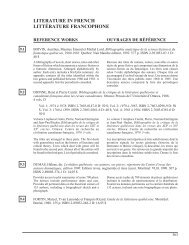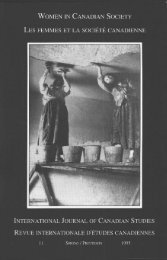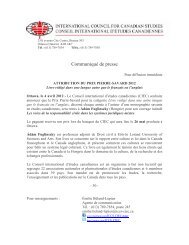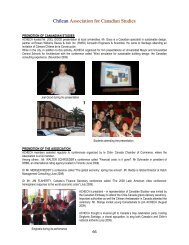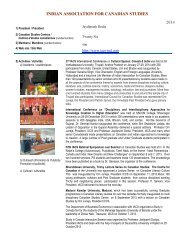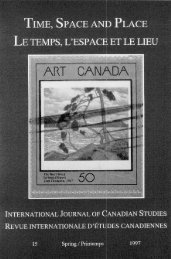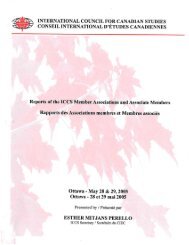Arts and Literature in Canada:Views from Abroad, Les arts et la ...
Arts and Literature in Canada:Views from Abroad, Les arts et la ...
Arts and Literature in Canada:Views from Abroad, Les arts et la ...
- No tags were found...
Create successful ePaper yourself
Turn your PDF publications into a flip-book with our unique Google optimized e-Paper software.
IJCS/RIÉCL<strong>and</strong>scape seems most suited to an <strong>in</strong>vestigation of perspective, as it onlyexists as a portion of the earth perceived <strong>and</strong> apperceived <strong>in</strong> a certa<strong>in</strong> way. 6Studies of environmental perception confirm that “‘[l]<strong>and</strong>scape’ ... is aconstruct of the m<strong>in</strong>d” (Yi-Fu Tuan 1979: 6), the construction depend<strong>in</strong>g on aperson's <strong>in</strong>dividual disposition as well as the pervasive notions of his/hersocial <strong>and</strong> cultural environment. 7 The perception of l<strong>and</strong>scape as l<strong>and</strong>scapealso dem<strong>and</strong>s a particu<strong>la</strong>r outlook of the corporeal eye; it is “a view or prospectof natural <strong>in</strong>l<strong>and</strong> scenery, such as can be taken <strong>in</strong> at a g<strong>la</strong>nce <strong>from</strong> one po<strong>in</strong>t ofview” (OED). The pert<strong>in</strong>ence of this def<strong>in</strong>ition to pa<strong>in</strong>t<strong>in</strong>g is obvious, y<strong>et</strong> thesame visual criterion seems to differentiate the po<strong>et</strong>ry of l<strong>and</strong>scape <strong>from</strong> thepo<strong>et</strong>ry of nature. In many examples of English Romantic po<strong>et</strong>ry, for <strong>in</strong>stance,the use of the word “l<strong>and</strong>scape” is conspicuously tied to precisely localizedviewpo<strong>in</strong>ts, as <strong>in</strong> Wordsworth's “T<strong>in</strong>tern Abbey”: “The day is come when Iaga<strong>in</strong> repose/Here, under this dark sycamore.”L<strong>and</strong>scape emerges as a subject where visual <strong>and</strong> mental perspectives coalesce<strong>in</strong> an almost exemp<strong>la</strong>ry fashion. In Anglo-Canadian l<strong>and</strong>scape po<strong>et</strong>ry, visualperspectives serve as corre<strong>la</strong>tives to <strong>in</strong>dividual as well as cultural views of thel<strong>and</strong>.It is a commonp<strong>la</strong>ce of Canadian Studies that Canadian culture has beenshaped by the experience of the country's geography <strong>and</strong> natural world, <strong>and</strong>Canadian l<strong>and</strong>scapes have been a prime subject of both Canadian pa<strong>in</strong>t<strong>in</strong>g <strong>and</strong>po<strong>et</strong>ry. Gaile McGregor's The Wacousta Syndrome (1985) is one of manystudies to def<strong>in</strong>e the Canadian l<strong>and</strong>scape experience as one of a “beleagueredhuman psyche attempt<strong>in</strong>g to preserve its <strong>in</strong>tegrity <strong>in</strong> the face of an alien,encompass<strong>in</strong>g nature” (5). McGregor cites visual perspective <strong>in</strong> Canadianl<strong>and</strong>scape pa<strong>in</strong>t<strong>in</strong>g as evidence of this view. The basic orientation <strong>in</strong> thesepa<strong>in</strong>t<strong>in</strong>gs is an “anti-panoramic” one, with a notable tendency for <strong>in</strong>dist<strong>in</strong>ctbackgrounds, horizons that are “raised or hidden by features <strong>in</strong> the fore-tomiddleground,” low viewpo<strong>in</strong>ts, <strong>and</strong> other techniques that delimit the sense ofa pa<strong>in</strong>t<strong>in</strong>g's spatial depth (17f.).These observations can be reformu<strong>la</strong>ted <strong>in</strong> terms of a theory developed by theBritish geographer Jay Appl<strong>et</strong>on (1975): a person's capacity to feelcomfortable <strong>in</strong> <strong>and</strong> appreciate a l<strong>and</strong>scape depends on the degree to which thel<strong>and</strong>scape's hazard potential is dim<strong>in</strong>ished by its potential for prospect <strong>and</strong>refuge—see<strong>in</strong>g without be<strong>in</strong>g seen. 8 Accord<strong>in</strong>g to Appl<strong>et</strong>on, unrestrictedpanoramas <strong>and</strong> vistas constitute powerful factors of prospect (85ff.).Basically, the opportunity for prospect dim<strong>in</strong>ishes the environment hazard, butan excess of prospect makes for a negative experience—the surveyable l<strong>and</strong>becomes a l<strong>and</strong>scape of “exposure” (151). In light of this theory, the Canadianpa<strong>in</strong>ters' h<strong>and</strong>l<strong>in</strong>g of perspective (as described by McGregor) may be<strong>in</strong>terpr<strong>et</strong>ed as a strategy for reduc<strong>in</strong>g the excess of prospect that so manyCanadian l<strong>and</strong>scapes present.10



